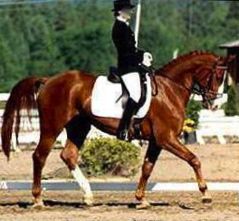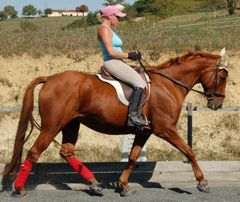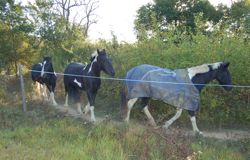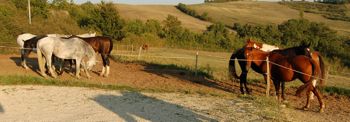

The Dark Side Of DependencySpotlight On Management: The Benevolent Choice When mankind captured wild horses and domesticated them, we began to change their ability to look after themselves. Seen in a positive light this is a kind of exchange: if you give us the advantages of your strength to pull and carry, we will give you food and shelter and safety. This kind of bartering between species is part of the history of our planet. Of course, usually one species is dominant in the sense that the 'partnership' is their idea in the first place, and they have the choice as to what extent it is a relationship of slavery or benevolence. In the case of humans and horses, this choice is our responsibility, and if we are going to continue to exploit horses, the least we can do for them is to respect their essential nature in a way which compensates for the loss of their freedom. Comfort versus freedom is a choice we all understand, and feel more or less strongly about either way. Do we really know what constitutes comfort for a horse however? Some of us think that horses are comfortable in the relative shelter of a stable. Why then will horses rarely stay in a stable when they have the choice? Maybe because they don't know what is good for them, or perhaps because in fact, they do. Instinctively they seek movement which stimulates their physical health, and interaction which stimulates their mental health. As for shelter, seek out any horse during a storm, and it is obvious they have a comprehension we have long forgotten. The characteristics which make up the animal we call a horse happen to be the characteristics which allowed their survival on this planet throughout the ages. Of course they have changed radically over this time, and we have changed them further, but the time span is exceptionally long in comparison with the actual changes. Like a lock and a key, the natural life of a horse is perfectly suited to their nature, physical and mental. When we start to change aspects of it here and there, we start to destroy the integrity of the positive circle, where one aspect reinforces another, for example horses who are together tend to move more, and when they move, their digestion is healthier and their body can develop and heal itself more effectively because it can more readily gauge it's soundness in relation to the external environment. Creating this positive cycle is perfectly possible if we choose to do it. An alternative management solution such as Paddock Paradise is one of the ways we can do this. On the other hand, the less we allow this natural reinforcement, replacing it with our human inventions i.e small spaces, drugs, isolation and interventions on any level, the more our horses rely on that and depend on us. Dependency in this way is akin to people connected to life support machines. Our horses become progressively weaker and more dysfunctional.
The Parallels With Training

How does this relate to how we ride and train our horses? If the rider seeks to control the horse by means of forceful containment (top photo, right), in the same way as restricting his freedom of movement in his lifestyle in general, the result will be a horse who is degraded and weakened by his work, and becomes less and less able to support himself. 
The ideal horse and rider partnership is one in which the rider facilitates the independence of the horse. This means that a horse is balanced and straightened sufficiently by the rider's posture that he can carry his own body, as well as his rider's, in an elegant but powerful manner(lower photo, right) This training requires the development of independence in the rider's posture both from the reins and between leg and seat, so that the rider can then allow the horse his freedom of movement at the same time as channeling it. Interestingly, this riding posture is the physical equivalent of the mental independence we must develop which allows us to keep our horses in as free and natural a lifestyle as possible.
New on Happy Horse Training: Share your own barefoot story and create your own page on the site! Go to: The Barefoot Horse Revolution: Share Your Story! Click here also to read other people's barefoot experiences. New pages on HHT: From Dummy Foal to Passive Leader: Xas's Story Horse Diseases Different Barefoot Trims: Our Hoof Care Journey Octavia's Story: Is An Aggressive Horse Brave or Just Insecure? Life's Innate Healing Potential Click here to visit Happy Horse Training New! CommentsAnything to say about this page? Leave your comment in the box below. |
Join the Whole Horse Newsletter
HHT's free monthly newsletter giving you wide-ranging and intelligent insights into holistic horsemanship.
Just enter your details below to join.
Free bonus on the riding position with all new subscriptions: Ten Top Tips To Instantly Improve Your Connection With Your Horse.
Train Your Horse
The Holistic Way
How To Train A Horse Without Force is a unique guide to training horses through energetic connection and gymnastic training. Part 1 covers everything on the ground, from handling to the lungeing technique that develops strength, straightness and engagement. Comes with a free eBook supplement on Horse Trauma.
Click here for more details.
Do You Have
A Horse Story
To Share On HHT?
So many people have been through wonderful experiences with horses, whether in training or otherwise. If you've made a change in a horse's life - or one has made a change in yours - tell us about it here.
Learn How To Trim
Your Own Horse's Feet
The Simple Seven-Step Natural Trim is a comprehensive step-by-step guide to a cutting-edge barefoot trim. Click here to find out more.
 Some of us think that horses are safer kept apart from each other because they might play or fight, and damage themselves. There are few damages more consequential for health than psychological ones however. We may have nice gleaming horses with untouched coats and unmarked legs, but the occupants of these perfect bodies have long since lost their natural presence and curiosity for life.
Some of us think that horses are safer kept apart from each other because they might play or fight, and damage themselves. There are few damages more consequential for health than psychological ones however. We may have nice gleaming horses with untouched coats and unmarked legs, but the occupants of these perfect bodies have long since lost their natural presence and curiosity for life.



